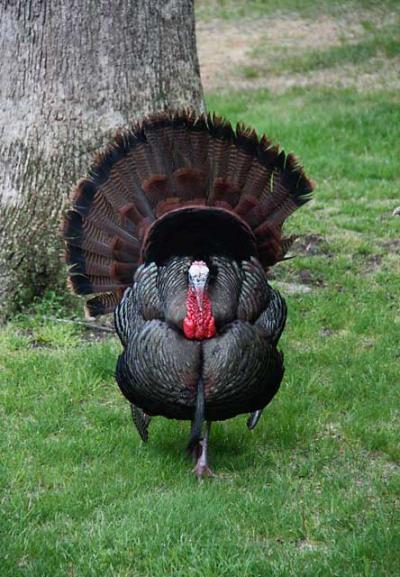Nature Notes: It’s a Fowl Ball!

In only 20 days, the daily photoperiod will start to wane. Perhaps that’s why almost all of nature is focused on reproducing. Osprey eggs are hatching. Crows are roaming the treetops looking for unguarded nestlings. On Saturday shortly after noon a screech owl up the block started singing his wavering whistle in full daylight. The first tropical storm hit the Florida panhandle on Memorial Day. Observers were quick to blame “global warming.” Hmmm. I wonder.
One hundred and fifty years ago, if you lived at the edge of the Hempstead Plains, once the largest grasslands in eastern North America, you might have been roused from your sleep by the popping sounds of male heath hens promenading in front of an onlooking coterie of females while trying to woo them. The last heath hen, Booming Bob, died on Martha’s Vineyard in 1932. Today in a few Long Island spots one can still hear the drumming of the ruffed grouse, a bird that used to be plentiful here in the Northwest Woods. I haven’t heard of one seen locally since before 2000.
As a boy in Mattituck I woke up each spring to the songs of bobwhites. There are still a few around. A few were heard last year “bob, bob whiting” in Montauk east of Lake Montauk. Ground-nesting birds have become very scarce hereabouts. One that isn’t, however, is the wild turkey, which was reintroduced into Hither Woods in January of 1991 and is now likely to be spotted every spring on almost all the back roads of the South Fork. The male wild turkeys spread their magnificently plumed tails when courting; the one with the prettiest display usually gets the females.
Courting is pretty much over now and precocial wild turkey chicks are already running around feeding on their own, protected by their mother.
The Morton Wildlife Refuge in Noyac is just one of the local spots where you can observe these large birds up close. The males are not only the owners of a beautiful tail, they are also equipped with other devices to get a female’s full attention, namely a fleshy red wattle hanging from the chin and a beard of black feathers protruding from the chest. While keeping a roadkill tally each year since 1982, I am pleased to say I have encountered only a handful of run-over turkeys. Is it because they seldom bolt across a road as deer do? When they do cross, they strut, and usually in the company of others. Because of their size they are hard to miss.
You may have noticed that the local mated pairs of Canada geese already have goslings in tow, whether in the water or on land. Of the thousands of geese that overwinter here, it is hard to know what percentage skip the breeding migration north to nest locally. Is it the young of the local breeders that tend to follow in their parents’ footsteps and choose to skip the flight north? Likewise, mallard ducks have hatched out their young and any pond or creek on the South Fork is bound to have a mallard family growing up but not yet fledged. The seasonally high counts of coliform and enterococcus bacteria encountered in local ponds, say, Georgica and Lake Agawam, are partially attributable to these two waterfowl species.
Some observers have reported to me that mute swan nests seem to be less common than usual. In the winter months these nonmigratory waterfowl gather together in larger ponds that are unlikely to freeze solid for long periods of time, such as Georgica Pond and Mecox Bay. When ice does force them out, they usually sit in the marine waters, especially those parts of the Peconic Estuary that are salty and very rarely freeze over. During courting a female mallard is usually accompanied by two males, but Canada geese and mute swans are about as monogamous as a species can be. It’s easy to tell a male mallard or wood duck from their female counterpart, hard to tell a monogamous male Canada goose from its female courtesan, or the monogamous cob swan from its pen.
Almost all of the other waterfowl go north to breed. Each summer groups of scoters and eiders hang around in the ocean or Block Island Sound just offshore. It is believed that these are birds that have yet to reach maturity, so why not hang around with the tourists and enjoy the underwater mussels and the like while doing so?
Come July, the osprey and bald eagle young will begin to develop their wing strokes while in the nest, and shortly after they’ll be learning how to dive for fish, or in the fledgling eagle’s case, how to steal fish from the fledgling ospreys.
Meanwhile, local populations of oystercatchers, willets, and black skimmers continue to grow. The willets breed in salt marshes, the oystercatchers and skimmers often breed proximate to tern colonies to take advantage of the terns’ aggressive protective behavior when set upon by unwanted visitors. Gardiner’s Island is a favorite spot for them. And let us not forget the cormorants. They nest in tree rookeries, the closest one to the South Fork being found on Gardiner’s Island.
It wasn’t too long ago when all of these water bird species, along with the black-crowned night heron, snowy egret, and great egret, were either missing or uncommon. Given protection, however, they are thriving. And let’s not forget the importance of the foodstocks in the local waters they rely on, just as the fishermen do. Let’s hope there is enough to go around. As long as the sand eel and bunker populations are not in trouble, however, there is usually enough food to go around, and I’m told that those two fish populations are just ducky for the moment.
Larry Penny can be reached via email at [email protected].
